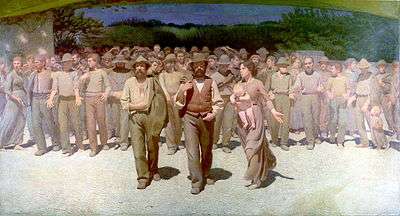Giuseppe Pellizza da Volpedo

Giuseppe Pellizza da Volpedo (July 28, 1868 – June 14, 1907) was an Italian neo-impressionist painter. He was born and died in Volpedo, in the Piedmont region of northern Italy.
Pellizza was a pupil of Pio Sanquirico. He used a divisionist technique in which a painting is created by juxtaposing small dots of paint according to specific color theory.
His most famous work, Il Quarto Stato ("The Fourth Estate") (1901), has become a well-known symbol for progressive and socialist causes in Italy, and throughout Europe. The painting is shown during the opening credits of Bernardo Bertolucci's film 1900 and is currently housed at the Museo del Novecento in Milan. An earlier version is held in the Pinacoteca di Brera.
Pellizza hanged himself in 1907, after the deaths of his wife and son.[1]
References
| Wikimedia Commons has media related to Giuseppe Pellizza da Volpedo. |